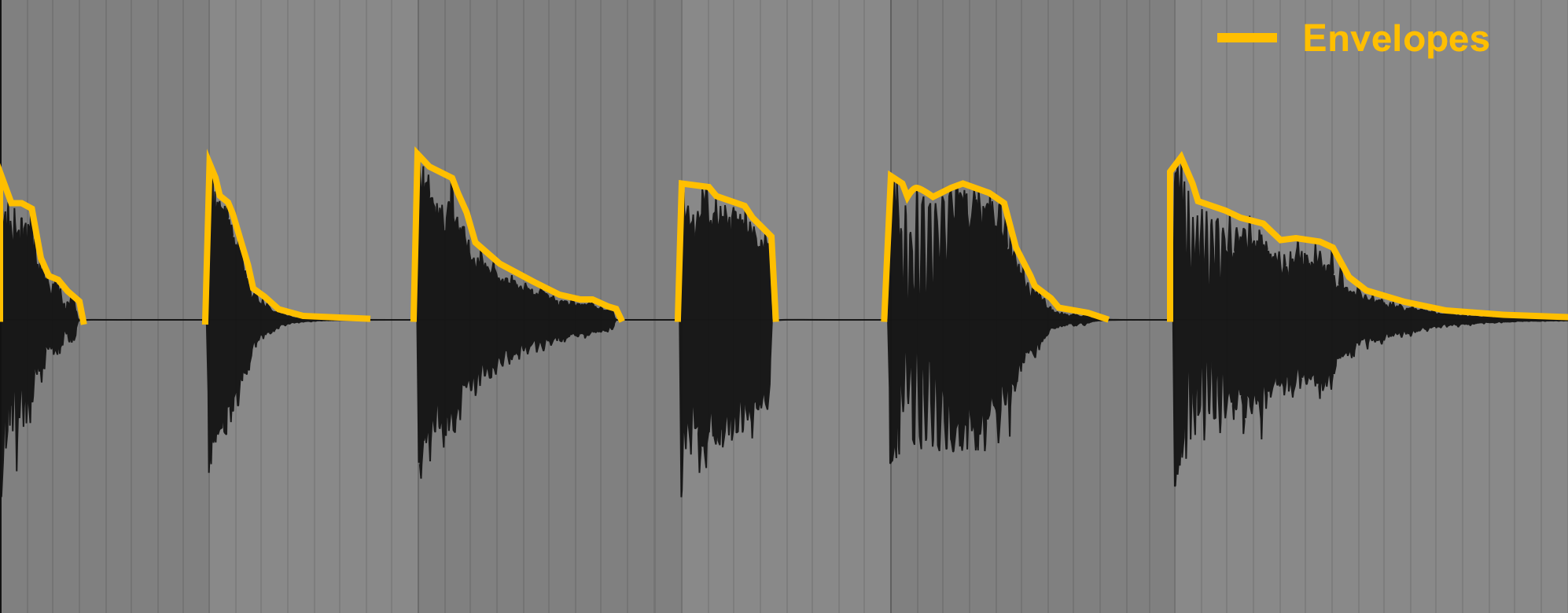Contents
1. Amplitude Envelope
Last time you learned about the spectrum and overtones, but another fundamental parameter related to timbre is the temporal change in volume. For example, with snare drum sounds, some have a short, quick decay like “tac”, while others have a long sustain like “zaaahn”.
Within a single hit, when the volume reaches its peak and how it decays are significant factors that deeply influence timbre and, consequently, the sense of rhythm and groove in a song.
The shape of volume is readily apparent when you look at the waveform curve. Such curves representing the volume change in time is called an Amplitude Envelope, or simply an “envelope” for short. (In the following, I’ll use ENV as an abbreviation.)
The term “ENV” is familiar in the world of synthesizers. That’s because designing the volume variation is an essential element in creating the desired timbre with synthesizers.
The iconic synth sound in the intro of “Symphony” by Clean Bandit is created from a sine wave. Sine waves, having no overtones, are supposed to be plain and tasteless, but by designing a soft mallet-like ENV, they achieve a fantastical timbre. This means that even if the spectral component is the same, the impression of timbre can change significantly based on ENVs.
Here are sounds made all from sine waves, with only ENVs changed. Each has its own personality. Last time we conducted an experiment suggesting that without overtones, all musical instrument sounds become as tasteless as water. I apologize; that was half a lie. Even with a completely overtone-free sine wave, you can characterize it through ENV designs. It’s akin to how water, despite being the same, can have entirely different properties, whether it’s ice, boiling water, or steam.
2. ADSR
The shape of an ENV can vary greatly, but in classic synthesizers, you adjust an ENV just with four parameters. Let me introduce them here.
Release Time
For example, consider the sound of a bell. If we shape its volume envelope, it will look something like this:
I’ve marked an arrow(▲) at the moment the sound starts. It begins with a strong initial strike, followed by a lingering decay, creating a shape like a slide. This “period from when the play action ends until the sound disappears” is known as Release Time.
Bells are an example of an instrument with an exceptionally long release time. The length of the release varies from one instrument to another and contributes to the individual character of their timbre. Even among similar mallet instruments…
In sequence, you hear marimba, xylophone, and vibraphone. Marimba and xylophone have shorter releases, while the vibraphone has a considerably longer release.
Attack Time
Many instruments reach their peak volume the moment they are played, but some have a slight delay before reaching their maximum volume. This “period from when the instrument is played until the volume reaches its peak” is referred to as Attack Time.
For instance, in some sound effects, you can observe very slow attacks.
Plucked instruments like guitars or percussion instruments generally have an instant attack, meaning the attack time is close to zero. However, bowed instruments like violins or wind/brass instruments offer more control over the attack time.
The control over volume through breath or articulation is quite versatile. Especially when you emulate orchestral sounds on your DAW with plugins, paying attension to such ENV characters can significantly enhance the quality of the composition.
Sustain Level
The play action of bells or drums ends in an instant, as soon as they are struck. In contrast, keyboard instruments like organs require a two-step action of pressing a key and releasing it, or wind instruments involve breathing and stopping. The amplitude during the period of sustaining a sound is referred to as the Sustain Level.
Organs, for example, maintain a constant volume from the initial “attack” and, therefore, have a sustain level of maximum, 100%. This is a relatively rare type, as with wind or brass instruments, there is typically a decrease in volume during the sustain phase compared to the moment of the initial attack.
Here is an example of trumpets blown vigorously. In this case, the sustain level is just a bit lower than 100%. In instruments played by breath, it is natural for the sustain to get lowered.
Pianos, too, can sustain sound by using the sustain pedal, resulting in a similar envelope.
Nevertheless, again, the sustain volume is slightly lower compared to the volume at the moment of striking the keys. Instruments that can easily maintain a sustain level of 100% include, besides organs, bowed string instruments like violins, or synthesizers.
Incidentally, percussion instruments (basically) do not have sustain, as they are incapable of actions like “blowing” or “holding keys” to keep the sound continue.
Decay Time
The time it takes to go from “Attack” stage to the “Sustain” stage varies depending on the performance. You can quickly reduce the volume immediately after the attack…
Or there are cases where the volume gradually decreases over a longer period.
The time it takes for the volume to decay from the maximum point to the sustain state is called the Decay Time.
If the volume drops quickly, the envelope is described as having a “short decay.”
In contrast, a performance where the volume slowly decays is described as having a “long decay.”
Both “decay” and “release” describe the time it takes for the volume to decrease. However, “decay” refers to the period while the performance is ongoing, while “release” refers to the period after the performance has ended.
Theoretical Models and Reality
ADSR was originally created for synthesizer sound design, breaking down amplitude changes into four parameters. In the context of real instrument performance, however, there are aspects that this simple terminology cannot fully describe.
For example, plucked/struck instruments gradually decay in volume, even when one tries to sustain the sound.
Pianos have a pedal called “sustain pedal”, which, when pressed, allows the sound to sustain even after releasing the keys. However, due to its structure, the sound will inevitably decay. Nevertheless, in perceptual terms, if you can sustain the sound for this long, it’s common to perceive it as being in the “Sustain” phase, even if the volume is gradually decreasing. (Otherwise the name “sustain pedal” will be seen as hype!)
In another example, consider cymbals. The ringing sound after being struck could be considered part of the “release” phase since it occurs after the play action.
However, when you listen to the words of professional musicians, he says in the video above “The sound isn’t done yet,” implying that the way they manipulate the cymbal after striking is a significant part of their performance. The moment they stop the cymbal’s resonance by pressing it against their body could actually be considered the “end of the performance.” In this context, the shimmering part might be seen as “decay” rather than “release”.
After all, these are classification concepts primarily prepared just for classic synths, so when applying them to other instruments, it’s best not to overthink the details.
Now, let’s finish explaining the important terms. When summarizing the words in order:
| Stage | Explanation |
|---|---|
| Attack | The time from the beginning of playing to reaching maximum volume |
| Decay | The time it takes to transition from peak to the “sustain” phase |
| Sustain | The volume maintained constantly after decay |
| Release | The time during which the resonance or reverberation decays after the play action is finished |
And Those can be visualized as follows:
Note that only “sustain” refers to volume, not duration. If you want to refer to the duration of the sustain phase, you can say “sustain time.”
These four terms, represented by their initials, are known as ADSR. It is recognized as fundamental parameters in synthesizers. However, ADSR is a crucial element not only in synths but also in the groove of all musical instruments. In particular, the decay shape of drums and percussions, the duration of sustain in every note played on guitars or pianos, and the subtle volume fluctuations in vocals…… all these have a significant impact on the rhythm and feel of a song.
Let’s Update Our Ears
In the Introduction Chapter I said that without music theory you cannot “watch” music—Only through linguistic comprehension does it become possible for humans to analyze and memorize musical structure. The concept of envelopes is exactly like that. Just by understanding this concept, the amount of information that comes to you when listening to music will change significantly.
Here are some avant-garde electronic music tracks that might make ordinary people say, “I don’t understand what’s good about it.” However, if you listen carefully now, you should be amazed at how delicately each envelope is constructed.
Sounds with a short decay emphasizing the attack, sounds sustaining monotonously, sounds with a slow Attack, and sounds that instantly disappear with zero release… Just like various chords bring color to a song, diverse envelopes also add richness to a composition. The envelope greatly influences the groove of music, but we’ll delve into that in detail in the Rhythm theory section.
Amplitude envelope is super-super-ultra important. It’s arguably at the core of music. Because, you see, while music without harmony or melody is possible, music without an envelope is unimaginable—As long as the fact remains that music is vibrations in the air.
Theory, Too Dazzling, Blinds You.
In music theory, there are relatively few discussions about timbre. However, that doesn’t mean timbre is unimportant in music. On the contrary, it’s often ignored precisely because the domain of timbre is so deep. Even something as simple as playing a chord can be different between a guitar and a piano, but those conditions are often disregarded.
As you become more knowledgeable in music theory, you may find yourself (unconsciously) focusing on systematically organized elements like harmony or rhythm. However, as you progress in your learning, don’t forget that the essence of music also resides in the information that doesn’t appear in sheet music.
Summary
- “Envelopes” are representations of the temporal changes in volume, shown as curves.
- Envelopes are most commonly divided into four stages: Attack, Decay, Sustain, and Release (ADSR).


